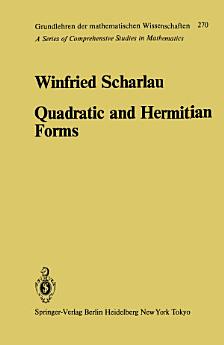Quadratic and Hermitian Forms
W. Scharlau
dec. de 2012 · Grundlehren der mathematischen Wissenschaften Libro 270 · Springer Science & Business Media
Libro electrónico
422
Páxinas
reportAs valoracións e as recensións non están verificadas Máis información
Acerca deste libro electrónico
For a long time - at least from Fermat to Minkowski - the theory of quadratic forms was a part of number theory. Much of the best work of the great number theorists of the eighteenth and nineteenth century was concerned with problems about quadratic forms. On the basis of their work, Minkowski, Siegel, Hasse, Eichler and many others crea ted the impressive "arithmetic" theory of quadratic forms, which has been the object of the well-known books by Bachmann (1898/1923), Eichler (1952), and O'Meara (1963). Parallel to this development the ideas of abstract algebra and abstract linear algebra introduced by Dedekind, Frobenius, E. Noether and Artin led to today's structural mathematics with its emphasis on classification problems and general structure theorems. On the basis of both - the number theory of quadratic forms and the ideas of modern algebra - Witt opened, in 1937, a new chapter in the theory of quadratic forms. His most fruitful idea was to consider not single "individual" quadratic forms but rather the entity of all forms over a fixed ground field and to construct from this an algebra ic object. This object - the Witt ring - then became the principal object of the entire theory. Thirty years later Pfister demonstrated the significance of this approach by his celebrated structure theorems.
Valora este libro electrónico
Dános a túa opinión.
Información de lectura
Smartphones e tabletas
Instala a aplicación Google Play Libros para Android e iPad/iPhone. Sincronízase automaticamente coa túa conta e permíteche ler contido en liña ou sen conexión desde calquera lugar.
Portátiles e ordenadores de escritorio
Podes escoitar os audiolibros comprados en Google Play a través do navegador web do ordenador.
Lectores de libros electrónicos e outros dispositivos
Para ler contido en dispositivos de tinta electrónica, como os lectores de libros electrónicos Kobo, é necesario descargar un ficheiro e transferilo ao dispositivo. Sigue as instrucións detalladas do Centro de Axuda para transferir ficheiros a lectores electrónicos admitidos.








